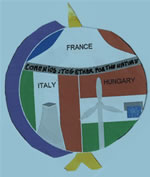Utilisation of the solar energy:
Extracting as much energy as possible from our star, the Sun is a worldwide tendency. It is more and more obvious for us that if we want to save the green environment we have to use renewable energy instead of traditional energy resources.
We produce about 80% of energy requirements on Earth by burning the currently popular fuels like coal, natural gas and oil. Earth can serve us with coal probably in the next two centuries and the gas stocks are sufficient for 50 more years as per latest tests.
We pollute our environment with the impurities disengaged during combustion. This dirt could end in acid rain that destroys the forests or trigger smog and accelerate global warming (Green house effect). We have to protect ourselves and the environment against these harmful impacts by increasing the usage of renewable energy at the expense of regular energy resources.
These new resources are available almost everywhere and we will not run out of them in contrast of the old energy stocks. We also have to note that their pollution is negligible. Renewable energy uses natural resources such as sunlight, wind or geothermal heat. One of the most favourable is solar energy.
What is the solar energy?
Solar energy is the energy that is released inside the core of the Sun during fusion processes. This energy is delivered to us by the sun-ray.
The most popular way to use polar energy is the sun-cell or photovoltaic panel. This is usually a flat plate collector that converts the sunlight into electricity and even heat water at the same time. The installation of the photovoltaic panel is a good investment that could return within a few years and it also could be a showy part of your house.
The most important advantages of the utilisation of solar energy are the following:
-unrestricted availability
-using solar energy makes the fossil fuel resources longer accessible to feed other fossil-based requirements
-it is clean, natural and therefore environmentally sound
-does not need to transport
The methods of using the solar energy are:
•Passive
•Active
The passive way is used in the architecture. That means that our every day buildings can be designed to use the energy of the sun without special mechanical devices. A well-designed building sitting naturally grasps, stores and utilises as much solar energy as possible. The saving of these architectural solutions is up to 15-20% in contrast to the traditional one.
Different devices such as collectors, solar furnaces or heat-pumps have been developed to produce as much energy as possible from the sunlight. The liquid and air-collectors are widespread vehicles of the use of solar energy. These devices can be used for heating our houses or heating water either in our homes or camping sites or swimming pools. The air-collector is getting more and more popular to dry farm produces and fruits. The photoelectrical devices transform the power of the sun directly into energy by sun-cells without pollution. They can be used for 20 years if they were constructed from the proper materials. Their price would be competitive if they were in active demand.
The utilisation of the solar energy in Hungary:
The natural capabilities of our country make it possible to profit of the solar power. The number of sunny hours is 2000-2200 hours/year in Hungary which is the European average. That means that the performance of a square metre of sun-cells is 1200-1800 kWh. This value is more or less the same as in the Netherlands, Germany and Switzerland where the extensive utilisation of solar energy is a priority governmental objective. The European expectations inspire increasingly to use the new energy resources. The regulations of the European Union necessitate that the utilisation of the renewable resources would cover 60% of the energy requirement by 2050.
Point of interest: the largest solar photovoltaic power station of the world
The world’s largest solar photovoltaic system was commissioned in 2005 in Mühlhausen, Germany. The performance of the Bavaria Solar Park is almost 6,8 million kWh per year that can meet the energy requirement of about 2000 homes. The subservient surface of the clustered solar panels is 250k square metres. The construction of this park was a €50 million project. The main goal of the German administration is to cover the whole electricity requirement of the country by renewable energy.


